|
|
|
Sort Order |
|
|
|
Items / Page
|
|
|
|
|
|
|
| Srl | Item |
| 1 |
ID:
127466
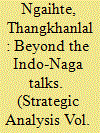

|
|
|
|
|
| Publication |
2014.
|
| Summary/Abstract |
More than 16 years have passed since the government and the National Socialist Council of Nagalim (Isak-Muivah faction, or NSCN(IM))1 initiated peace talks that have come to be known as the Indo-Naga peace process.2 More than 70 rounds of talks were said to have been held during the period 1997-2012. If the Naga insurgency dating from 1954 is the longest-lived insurgency in the world today,3 the 16-year-long peace process is also equally unprecedented. The talks were based on three procedural principles: that they be conducted without pre-conditions; that they be conducted at the highest, prime ministerial level; and that they be held outside India. These 'rites of negotiation' carry more than symbolic value. As Samir Kumar Das observed, 'It is perhaps the first time in history when the Constitution as an original document was no longer considered the beginning with a view to make a new beginning'.4
Despite the lofty rhetoric, the talks soon unravelled. By and large, the core agenda evolved from the original Naga demand of sovereign statehood to integration of Naga-dominated areas in India, and now to some form of non-territorial integration model. Despite these compromises and climb-downs on the part of the Nagas, and despite a broad political consensus in India in favour of a negotiated solution, resolution of the Naga problem seems as remote now as it was in 1997, when the present peace process started.
|
|
|
|
|
|
|
|
|
|
|
|
|
|
|
|
| 2 |
ID:
127465
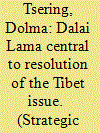

|
|
|
|
|
| Publication |
2014.
|
| Summary/Abstract |
Since June 2013, there has been a spate of activity on the Tibet controversy. Sparking it off was the interview of Professor Jin Wei1 from the Central Party School in Asian Weekly2 on June 6, entitled 'Reopen Talks and Resolve Tibetan Issues', in which she advocated engaging the Dalai Lama rather than demonising him. Soon after, the International Campaign of Tibet reported that China had lifted the 17-year ban on the display of Dalai Lama portraits in Sichuan and Qinghai. On the other hand, on July 6, the Tibetans who had gathered to mark the 78th birth anniversary of the Dalai Lama in Tuwa county were fired upon by Chinese security forces. The State Administration for Religious Affairs reiterated: 'Our policy toward the Dalai clique is clear and consistent, and has not changed'.3 Yu Zhengsheng, a member of the Standing Committee of the Political Bureau of the Communist Party of China (CPC) declared: 'Only when the Dalai Lama publicly announces that Tibet is an inalienable part of China since ancient times, gives up the stance of "Tibet independence" and stops his secessionist activities, can his relations with the CPC Central Committee possibly be improved'.4 These developments suggest that China continues to remain serious about resolving the Tibet issue, especially regarding the Dalai Lama's role. This commentary seeks to analyse different aspects of understanding on the Dalai Lama's role in the resolution of the Tibet issue.
|
|
|
|
|
|
|
|
|
|
|
|
|
|
|
|
| 3 |
ID:
127471
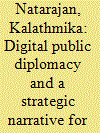

|
|
|
|
|
| Publication |
2014.
|
| Summary/Abstract |
States articulate their identity and foreign policy interests in the international system, seeking to influence the perceptions of others and to create an environment in which their goals and efficacy as an actor are viewed as legitimate. In the age of mass communication technologies and new media, the public diplomacy initiatives utilised to communicate these narratives have gone digital. This article studies how India has utilised this new media environment for its public diplomacy and argues that digital diplomacy should be conceptualised as a larger set of practices that form an integral part of diplomacy itself: to communicate foreign policy goals and decisions, construct a strategic narrative of Indian foreign policy and counter narratives inimical to Indian interests.
|
|
|
|
|
|
|
|
|
|
|
|
|
|
|
|
| 4 |
ID:
127464


|
|
|
|
|
| Publication |
2014.
|
| Summary/Abstract |
In the run-up to the May 2013 elections, the political scene in Pakistan was absorbed in electoral rhetoric, active campaigning and a hectic poll process. It culminated with an expected set of results-the Pakistan Muslim League-Nawaz (PML-N) emerged victorious and took the reins of power after a decade and a half. The incumbent Pakistan People's Party (PPP) was nearly decimated and Imran Khan's Pakistan Tehreek-e-Insaf (PTI) marginalised. Meanwhile, during the entire electoral process and the eventual change of guard, Pakistan-occupied Kashmir (PoK), that is, the so-called Azad Jammu and Kashmir (AJK) and Gilgit Baltistan, remained on the political periphery, even though they have been under Pakistan's control for more than 65 years. Deprived of a provincial status, neither region within PoK is entitled to participate in the national assembly elections of Pakistan. The only representation PoK has in the federal government is through the Ministry of Kashmir Affairs and Gilgit Baltistan (KAGB).
|
|
|
|
|
|
|
|
|
|
|
|
|
|
|
|
| 5 |
ID:
127468
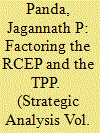

|
|
|
|
|
| Publication |
2014.
|
| Summary/Abstract |
The Regional Comprehensive Economic Partnership (RCEP) and the Trans-Pacific Partnership (TPP) are not necessarily two contending trade liberalising models, but their import and arrival have posed stiff political challenges for many countries, including China and India, Asia's two heavyweights. With these two initiatives, the regional trade of Asia is entering an interesting phase of liberalisation and integration. In fact, it is gradually becoming clear that the facets and nuances attached to these two trade liberalisation models will impact regional power politics massively in times to come. While the success of TPP hinges on the global economic authority of the US and how the negotiation process unfolds, the future dynamism of RCEP will depend heavily on how China and the Association of South-East Asian Nations (ASEAN) conduct their negotiation process and accommodate the interests of other regional powers, including India. Hitherto, it has been no secret that both RCEP and TPP will greatly affect and influence ASEAN and the role of its free trade agreement (FTA) partner countries, including China and India. In this regional stratagem, China-India relations may witness new dynamics and power politics in East Asia or in the broader Asia-Pacific region. It may also open a new window of opportunity for India's greater integration with the East Asia region. India needs to analyse carefully the efficacy and implications of both RCEP and TPP to see how far they serve New Delhi's own regional interests. RCEP may eventually facilitate India's 'Look East' policy more effectively than TPP. The former allows New Delhi to coordinate with ASEAN+6 countries more effectively, to which China has so far been fundamentally opposed.
|
|
|
|
|
|
|
|
|
|
|
|
|
|
|
|
| 6 |
ID:
127467
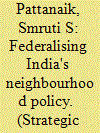

|
|
|
|
|
| Publication |
2014.
|
| Summary/Abstract |
The politics of coalition has posed new challenges to India's foreign policy. This problem becomes particularly evident in India's neighbourhood, which inevitably becomes intertwined with domestic politics. The rise of regional political parties and their role as coalition partners makes it more difficult for the union government to ignore provincial sentiments. Competitive politics featuring both national and regional political parties provides primacy to local interest as this is linked to the vote bank politics. Given the fact that coalition politics has become a reality, this article analyses how to engage the states and make them stakeholders in furthering India's neighbourhood policy.
|
|
|
|
|
|
|
|
|
|
|
|
|
|
|
|
| 7 |
ID:
127469
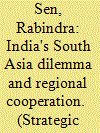

|
|
|
|
|
| Publication |
2014.
|
| Summary/Abstract |
This article highlights the current relevance of cultural diplomacy not as a panacea for the problems in India's relations with its South Asian neighbours but as a way of dealing with the dilemma it faces. Against the backdrop of India's position in South Asia and the importance of the region, the article makes an estimate of cultural diplomacy. Furthermore, it emphasises the need for redefining and reshaping India's cultural diplomacy not as a means of increasing its own influence but with a view to furthering the prospects of regional cooperation and thereby helping the process of peace-building in the region.
|
|
|
|
|
|
|
|
|
|
|
|
|
|
|
|
| 8 |
ID:
127463
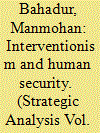

|
|
|
|
|
| Publication |
2014.
|
| Summary/Abstract |
The conflict in Syria is inexorably turning into a quagmire as more entities get dragged into the sludge. From a hands-off policy to one of humanitarian support, the West has progressed to arming rebels, while Russia has shown that it is determined not to let down its ally by continuing arms shipments to the Assad regime. Meanwhile, other actors are chipping in to add to the misery; the latest reports refer to Sudan sending arms to rebels through (and financed by) Qatar.1 As the crisis meanders into its third year, the chant of greater proactiveness from human security proponents is getting louder, reminiscent of international interventions of the past two decades in various parts of the world.
|
|
|
|
|
|
|
|
|
|
|
|
|
|
|
|
| 9 |
ID:
127470


|
|
|
|
|
| Publication |
2014.
|
| Summary/Abstract |
The objective of this article is to discuss defence cooperation between Malaysia and India in the post-Cold War era (1991-2012), mainly from Malaysia's perspective. The article is divided into four parts. First, the historical background of Malaysia-India defence cooperation during the colonial period until the Cold War is discussed briefly. Second, defence cooperation in the post-Cold War period involving the three services (air force, navy and army) is examined. Third, certain issues in Malaysia-India defence cooperation are analysed. The article concludes by arguing that in order for Malaysia to move towards more constructive defence relations with India, a paradigm shift is central to making the strategic partnership effective and meaningful.
|
|
|
|
|
|
|
|
|
|
|
|
|
|
|
|
| 10 |
ID:
127462
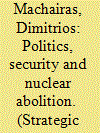

|
|
|
|
|
| Publication |
2014.
|
| Summary/Abstract |
Disarmament and non-proliferation are rightfully viewed as two sides of the same coin: the two imperatives that need to be met if the prospect of the complete elimination of nuclear weapons is to be realised. Although the existence of a link between the two concepts is obvious, the exact nature of this connection is perhaps not as clear. The central question here is whether it is politics or strategic realities that shape states' nuclear options and by implication, the two-fold road to global zero. Its answer is of great importance, indicating which tools and policies can be most appropriate for achieving this goal. This commentary employs logical/theoretical as well as factual analysis in order to show that the link between disarmament and non-proliferation is conditioned primarily by strategic realities rather than politics.
|
|
|
|
|
|
|
|
|
|
|
|
|
|
|
|
|
|
|
|
|